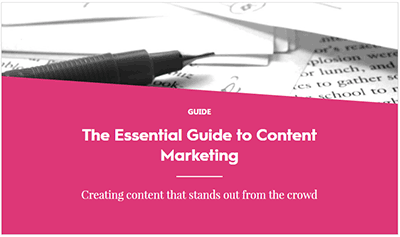Like so many other things in the world of digital marketing, content can become as complex as you want to make it. Concerns about purpose, promotion and strategy are all worthy things to spend your time thinking about.
When you get too bogged down in this kind of detail, it’s easy to forget the simple stuff – those basic rules that make written content work for your users.
No matter how much time you spend planning out your content marketing strategy, if your blogs are making people bounce or your guides are too bulky to read, then your strategy is probably going to fail.

Focusing On The Reader
When writing content, your reader needs to be at the forefront of your mind. You need to make sure that what you are creating won’t be off-putting or intimidating to the reader when they first land on a page – an issue further compounded by the nature of mobile devices.
Here are a few quick tips you can use to help make your content more user friendly.
1. Sub Headings
Sub headings are important for a number of reasons.
Sub headings break up the content on the page and prevent the reader from feeling like they’ve hit a ‘wall of text’ – something that is particularly off-putting on a mobile device.
They also help to guide the reader through the page. If they are on the page for something specific, then scanning the subheadings will help them find the section of the page most relevant to them.
This can again help to prevent reader frustration, which in turn has a benefit for you. Pages perform better when users are able to get what they want as quickly as possible.
How often should you have sub headings?
It depends – look for natural changes in topic in the copy. Purely from a signposting point of view, these are good places to have a sub heading.
To prevent ‘wall of text’, I’d recommend a sub heading every 4-5 paragraphs.
2. Keep Paragraphs Short
When it comes to writing for the web, a paragraph takes on a different shape when compared with writing for the page.
Generally, you want to keep paragraphs short. 4 lines is enough, you might be able to get away with 5 depending on the design and layout of your page. If you’re struggling to see where to break a paragraph, look for a change in topic or the start of a new point.
Again, this comes down to ‘wall of text’. What we’re trying to do is make the reader see the text as easy to digest, rather than as an intimidating slog to get through.
3. Bullet Lists are Better
When it comes to content that intimidates users and puts them off, a long, chunky list is one of the main offenders. Thankfully, bullet points can save you from creating a list that scares away otherwise engaged readers.
So, why are bullet lists better? Well…
- They present each individual point clearly
- They’re easier to scan
- They avoid a chunky block of text
- They’re much more digestible for mobile users
Wherever possible, bulleting your lists will make your content far more user friendly.

Signs of success
By taking these relatively simple steps, you’ll be well on the way to making your content more user friendly – particularly for those readers on mobile devices.
But what kind of tangible benefits should you expect to see? Making your content more accessible to readers should result in the following improvements on your content pages:
- A reduction in bounce rate
- Increased time on page
- Increased click-throughs and onward journeys
Of course, there are other factors that could affect these metrics – how well structured and positioned your calls to action are will effect onward journeys, for example.
Going beyond the basics
Content can be a complicated thing – that’s why it’s important to put best practice back in focus. After all, if you don’t get the basics right then the strategy you build around your content is likely to fail.
If you’d like to know more about content marketing, from basic content creation tips all the way up to multi-channel content marketing strategies, then we have a free guide that can help. The Essential Guide to Content Marketing – download your copy today!

